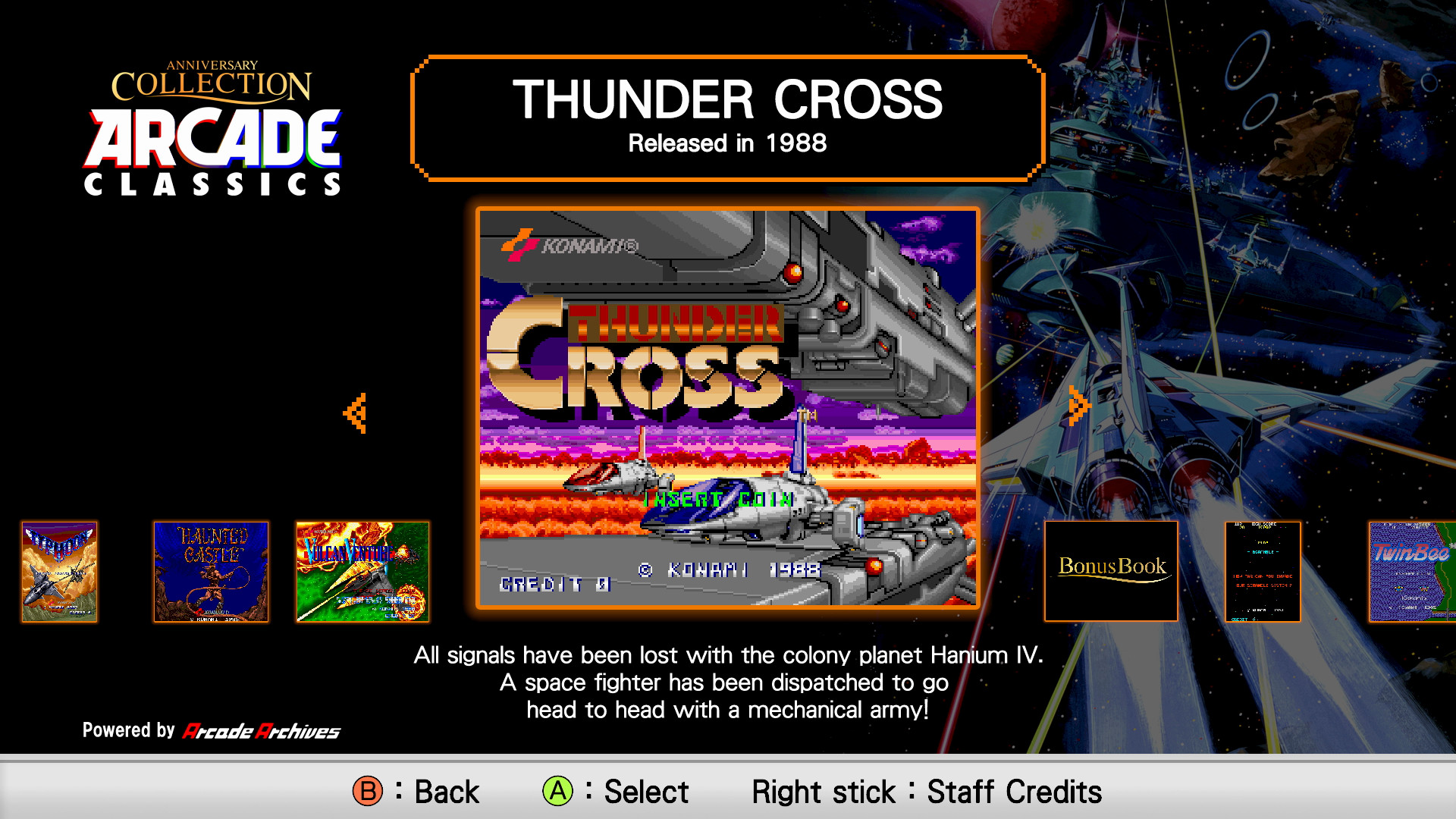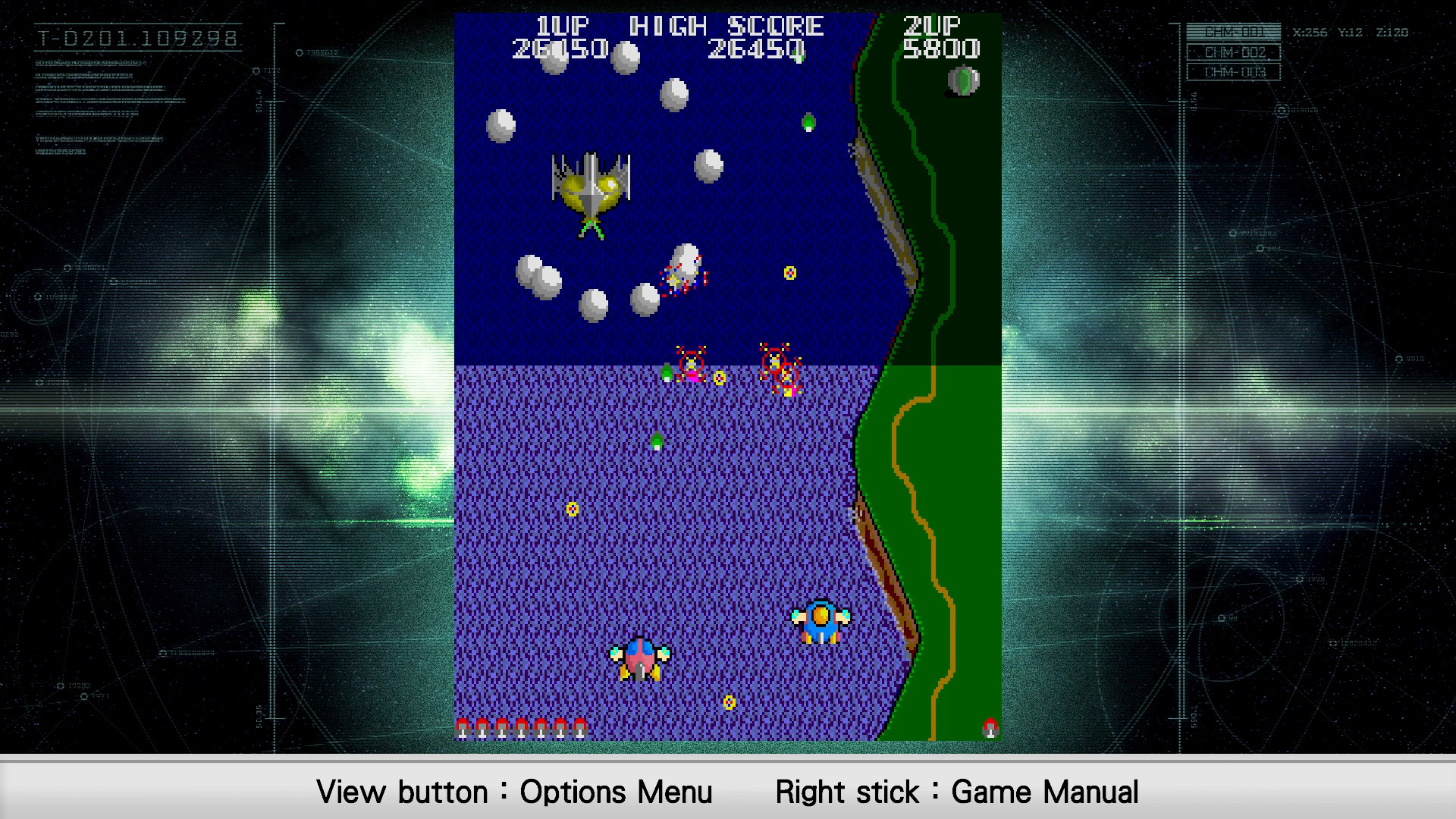

2019 has been a good year for compilations of classic arcade games, with SNK 40th Anniversary Collection finally getting a multiplatform release, and now Konami’s Arcade Classics Anniversary Collection has arrived on both consoles and PC. This one collects 8 classic arcade games (mostly shoot ‘em ups), three of which feature 2-player local co-op. While not as robust or polished as the SNK collection, shmup fans will still want to give Konami’s collection a look.

Arcade Classics Anniversary Collection includes the following eight games – seven shmups and one action-platformer:
Scramble (1981) TwinBee (1985) Nemesis (also known as Gradius) (1985) Life Force (also known as Salamander) (1986) Typhoon (also known as A-Jax) (1987) Haunted Castle (1988) Vulcan Venture (also known as Gradius II) (1988) Thunder Cross (1988)The selection of games is far from comprehensive, with dozens of Konami’s eighties arcade output nowhere to be seen. But we do get three games in the stellar and much-missed Gradius series and the painfully hard arcade version of Castlevania, Haunted Castle, so these eight games will still interest fans of classic Konami games.
We’re primarily concerned with cooperative multiplayer here, and three of this compilation’s games support 2-player local co-op:

TwinBee is a vertically scrolling shoot ‘em up, sometimes referred to as a cute ‘em up because of its whimsical art style. Both players pilot anthropomorphic ships that can fire regular shots forward and bombs at ground-bases targets, not unlike Xevious. If the ship’s arms take damage, it loses the ability to shoot bombs.
Uniquely among shoot ‘em ups, TwinBee has some distinct co-op mechanics, such as semi-friendly fire. Players’ shots can push each other around on the screen, so the team needs to coordinate their positions effectively. Both ships can link arms in order to fire more powerful shots. When this happens, one player controls movement for both ships. These mechanics and the cutesy art style made the first TwinBee distinctive for its time, but it’s a slow-paced game and much surpassed by later sequels.
Life Force is a spin-off of Gradius that takes place in largely organic-themed stages. The Gradius series’ unique manually-activated power-up system has been replaced by power-ups that automatically activate when collected.
Life Force’s claims to fame are its combination of both horizontally- and vertically-scrolling stages, and co-op. Interestingly, the game can only be continued when playing with a friend, making co-op significantly easier than single-player. Like most Gradius games, it also looks and sounds quite good.
Thunder Cross is a quality side-scrolling shoot ‘em up that has been rarely been ported to home consoles. Players pilot ships that start with an arsenal of two “options” (small, indestructible satellites) that can be expanded up to four. Thunder Cross is the only game in this collection that provides screen- filling bombs – a now-common shmup mechanic. Having arrived in 1988, it’s one of the best-looking games in the line-up.
Another way in which Thunder Cross stands out is by being the only game among Arcade Classics Anniversary Collection’s three co-op titles to allow unlimited continues. Inexplicably, early Konami arcade games usually allowed few, if any continues. The unlimited continues feature makes Thunder Cross more suitable for playing with casual shmup fans than TwinBee or Life Force. It’s a shame that Hamster (who developed this compilation for Konami) didn’t add an unlimited continues option to the other games as well.
Speaking of emulation features, Arcade Classics Anniversary Collection is a largely bare bones product. Japanese versions of the eight games, several of which feature different titles and gameplay tweaks, are not included here. The plain-Jane menus allow the use of save states, but not quick saves or instant rewinds. A couple of options (lives and difficulty) can be adjusted for each game, but several arcade dip switch settings remain inaccessible. Controls can be customized, and rapid fire turned on or off.
Display settings include a blurring option (which seems to enable scanlines, not antialiasing), original or widescreen screen ratios (no “tate” option here), and the choice between a scant two optional borders. The border selection is especially disappointing, as the same two borders are shared between all eight games. Why not include each game’s arcade artwork?
Achievements and Trophies are the one area in which Arcade Classics Anniversary manages to outdo SNK 40th Anniversary Collection. The $40 SNK collection offers a scant 14 Achievements/Trophies and doesn’t even include a Platinum Trophy on PlayStation. Konami’s $20 offering, meanwhile, has 17 Achievements/Trophies: two for each game, plus a Platinum for collecting the rest. The Achievements are all score-based, so you’ll probably find them easier to unlock in single-player than in co-op.
Even though Arcade Classics Anniversary Collection skimps on production values and emulator features, it does include one special feature: the 102-page Bonus Book. This book contains descriptions and concept art for all eight games, including some detailed level designs, as well as developer interviews. All text has been fully translated into English, which is really going the extra mile. The pages should’ve been a little higher resolution, but they’re still readable.
When compared against SNK 40th Anniversary Collection, Arcade Classics Anniversary Collection is obviously a smaller and less impressive product. But the eight games included here are still worth playing, other than, perhaps, the highly dated Scramble. TwinBee, Life Force, and Thunder Cross provide decent-to-great co-op shmup experiences, and the Bonus Book is a great read. Let’s hope that additional collections come along in the future, because Konami has plenty more arcade classics collecting dust in its archives.
The Co-Optimus Co-Op Review of Arcade Classics Anniversary Collection is based on the Xbox One version of the game. A copy of the game was provided by the publisher for review purposes.